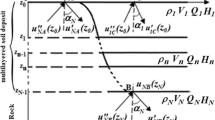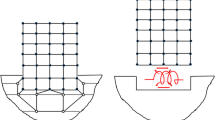Abstract
The available models for effective periods of site and structure are reviewed in context of frequency tuning in the inelastic seismic response of soil-structure system. The effect of seismic intensity and ductility demand, on the effective periods, is investigated, and inelastic site amplification is shown to be strongly correlated to the normalized effective period. Two non-dimensional parameters, analogous to the conventional site amplification factors in codes, are defined to quantify the inelastic site amplification. It is shown that the inelastic site amplification factor (i.e. ratio of constant ductility spectral ordinates at soil site to those at rock outcrop) is able to represent the site effects more clearly, as compared to the inelastic site amplification ratio (i.e. ratio of inelastic spectral ordinates at soil site to the corresponding elastic spectral ordinates at rock outcrop). Further, the peak in the amplification factor corresponding to the effective site period diminishes rapidly with increasing ductility demand.
Similar content being viewed by others
References
Adhikary S (2014), “Effect of Soil Conditions on the Seismic Response of Structures,” Ph.D. Dissertation, Department of Earthquake Engineering, Indian Institutre of Technology Roorkee, Roorkee, India.
Adhikary S, Singh Y and Paul DK (2014), “Effect of Soil Depth on Inelastic Seismic Response of Structures,” Soil Dynamics and Earthquake Engineering, 61: 13–28.
ASCE 7–10, (2010), Minimum Design Loads for Buildings and other Structures, American Society of Civil Engineers, Reston, VA.
Assimaki D, Li W and Fragiadakis M (2012), “Site Effects in Structural Response Predictions of Inelastic SDOF Oscillators,” Earthquake Spectra, 28(3): 859–883.
ATC 40 (1996), Seismic Evaluation and Retrofit of Concrete Buildings, Applied Technology Council, Redwood city, California, USA.
Athanassiadou CJ, Karakostas CZ, Margaris BN and Kappos AJ (2011), “Displacement Spectra and Displacement Modification Factors, Based on Records from Greece,” Soil Dynamics and Earthquake Engineering, 31(12): 1640–1653.
Bardet JP and Tobita T (2001), “NERA: A Computer Program for Nonlinear Earthquake Site Response Analyses of Layered Soil Deposits,” Department of Civil Engineering, University of Southern California, Los Angeles, CA, USA.
Bardet JP, Ichii K and Lin CH (2000), “EERA: A Computer Program for Equivalent-Linear Earthquake Site Response Analyses of Layered Soil Deposits,” Department of Civil Engineering, University of Southern California, Los Angeles, CA, USA.
Cadet H, Bard PY and Rodriguez-Marek A (2012a), “Site Effect Assessment Using KiK-Net Data: Part 1. A Simple Correction Procedure for Surface/Downhole Spectral Ratios,” Bulletin of Earthquake Engineering, 10(2): 421–448.
Cadet H, Bard PY, Duval AM and Bertrand E (2012b), “Site Effect Assessment Using KiK-Net Data: Part 2-Site Amplification Prediction Equation Based on f 0 and V sz,” Bulletin of Earthquake Engineering, 10(2): 451–489.
Chenari RJ and Bostani Taleshani SA (2016), “Site Response of Heterogeneous Natural Deposits to Harmonic Excitation Applied to more than 100 Case Histories,” Earthquake Engineering and Engineering Vibration, 15: 341. https://doi.org/10.1007/s11803-016-0326-0.
Darendeli M (2001) “Development of a New Family of Normalized Modulus Reduction and Material Damping Curves,” Ph.D. Dissertation, Department of Civil Engineering, University of Texas, Austin.
Dickenson SA (1994), “The Dynamic Response of Soft and Deep Cohesive Soils During the Loma Prieta Earthquake of October 17, 1989,” Ph.D. Dissertation, University of California, Berkeley.
Dobry R, Oweis I and Urzua A (1976), “Simplified Procedures for Estimating the Fundamental Period of a Soil Profile,” Bulletin of the Seismological Society of America, 66(4): 1293–1321.
Dwairi HM, Kowalsky MJ and Nau JM (2007), “Equivalent Damping in Support of Direct Displacement-Based Design,” Journal of Earthquake Engineering, 11(4): 512–530.
Ergun M and Ates S (2014), “Comparing of the Effects of Scaled and Real Earthquake Records on Structural Response,” Earthquakes and Structures, 6(4): 375–392.
Eser M and Aydemir C (2011), “The Effect of Soil-Structure Interaction on Inelastic Displacement Ratio of Structures,” Structural Engineering and Mechanics, 39(5): 683–701.
FEMA 273 (1997), NEHRP Guidelines for the Seismic Rehabilitation of Buildings, Federal Emergency Management Agency, Washington, D.C., USA.
FEMA 356 (2000), Prestanard and Commentary for the Seismic Rehabilitation of Buildings, Federal Emergency Management Agency, Washington, D.C., USA.
FEMA 440 (2005), Improvement of Nonlinear Static Seismic Analysis Procedures, Federal Emergency Management Agency, Washington, D.C., USA.
Gazetas G (2006), “Seismic Design of Foundations and Soil-Structure Interaction,” Proceedings of the 1st European Conference on Earthquake Engineering and Seismology, Paper no. K7.
Gazetas G (2012) “Some Presumptions on the Nature of Base Excitation May Erroneously Affect the Response of Strongly Inelastic Systems,” Proceedings of the 15th World Conference on Earthquake Engineering, Sept. 24–28, Lisbon, Paper No. 69.
Ghofrani H, Atkinson GM and Goda K (2013), “Implications of the 2011 M9.0 Tohoku Japan Earthquake for the Treatment of Site Effects in Large Earthquakes,” Bulletin of Earthquake Engineering, 11(1): 171–203.
Gkatzogias KI and Kappos AJ (2015), “Deformation-Based Seismic Design of Concrete Bridges,” Earthquakes and Structures, 9(5): 1045–1067.
Grant DN, Blandon CA Priestley MJN (2005), Modelling Inelastic Response in Direct Displacement-Based Design, Report 2005/03, IUSS Press, Pavia, Italy, p. 104.
Gulkan P and Sozen MA (1974), “Inelastic Responses of Reinforced Concrete Structure to Earthquake Motions,” ACI Journal Proceedings (71: ACI).
Hachem MM (2004), “BISPEC: Interactive Software for the Computation of Unidirectional and Bidirectional Nonlinear Earthquake Spectra,” (ASCE).
Hancock J, Bommer JJ and Stafford PJ (2008), “Numbers of Scaled and Matched Accelerograms Required for Inelastic Dynamic Analyses,” Earthquake Engineering and Structural Dynamics, 37(14):1585–1607.
Hashash YMA, Groholski DR, Phillips CA, Park D and Musgrove M (2011), DEEPSOIL 4.0, User manual and tutorial.
Idriss IM and Seed HB (1968), “Seismic Response of Horizontal Soil Layers,” Journal of the Soil Mechanics and Foundations Division, ASCE, 94(SM4): 1003–1031.
Idriss IM and Sun JI (1992), “SHAKE91: A Computer Program for Conducting Equivalent Linear Seismic Response Analyses of Horizontally Layered Soil Deposits,” User’s Guide, University of California, Davis, California, pp.13.
Iwan WD (1980), “Estimating Inelastic Response Spectra from Elastic Spectra,” Earthquake Engineering and Structural Dynamics, 8(4): 375–388.
Jakka RS, Hussain M, and Sharma ML (2015), “Effects on Amplification of Strong Ground Motion Due to Deep Soils,” Geomechanics and Engineering, 8(5): 663–674.
Kramer SL (1996), Geotechnical Earthquake Engineering, Pearson Education, Indian LPE, New Delhi.
Kowalsky MJ (1994), “Displacement-Based Design-a Methodology for Seismic Design Applied to RC Bridge Columns,” Master’s Thesis, University of California at San Diego, La Jolla, California.
Kwan WP and Billington SL (2003), “Influence of Hysteretic Behavior on Equivalent Period and Damping of Structural Systems,” Journal of Structural Engineering, 129(5): 576–585.
Lermo J and Chávez-García FJ (1993), “Site Effect Evaluation Using Spectral Ratios with Only One Station,” Bulletin of the Seismological Society of America, 83(5): 1574–1594.
Lopez F (2002), “Does Liquefaction Protect Overlying Structures from Ground Shaking?” M.Sc. Dissertation, European School of Advanced Studies in Reduction of Seismic Risk, Rose School, p.105.
Miranda E (1993), “Site-Dependent Strength-Reduction Factors,” Journal of Structural Engineering, 119(12): 3503–3519.
Miranda E (2000), “Inelastic Displacement Ratios for Structures on Firm Sites,” Journal of Structural Engineering, 126(10): 1150–1159.
Miranda E and Bertero VV (1991), “Evaluation of Structural Response Factors Using Ground Motions Recorded during the Loma Prieta Earthquake,” CSMIP-1991.
Miranda E and Ruiz-Garcia J (2002), “Influence of Stiffness Degradation on Strength Demands of Structures Built on Soft Soil Sites,” Engineering Structures, 24(10): 1271–1281.
Mollaioli F and Bruno S (2008), “Influence of Site Effects on Inelastic Displacement Ratios for SDOF and MDOF Systems,” Computers and Mathematics with Applications, 55(2): 184–207.
Mukherjee S and Gupta VK (2002), “Wavelet-Based Generation of Spectrum-Compatible Time-histories,” Soil Dynamics and Earthquake Engineering, 22(9): 799–804.
Mylonakis G and Gazetas G (2000), “Seismic Soil-Structure Interaction: Beneficial or Detrimental?” Journal of Earthquake Engineering, 4(3): 277–301.
Nakamura Y (1989), A Method for Dynamic Characteristics Estimation of Subsurface Using Microtremor on the Ground Surface, Railway Technical Research Institute, Quarterly Reports.
Newmark NM and Hall WJ (1982), Earthquake Spectra and Design, Earthquake Engineering Research Institute, Berkeley, CA, 1982.
Pavel F, Vacareanu R and Lungu D (2013), “Bi-Normalized Response Spectra for Various Frequency Content Ground Motions,” Journal of Earthquake Engineering, 18(2): 264–289.
Pavel F, Vacareanu R, Neagu C and Andrei P (2014), “Bi-Normalized Response Spectra and Seismic Intensity in Bucharest for 1986 and 1990 Vrancea Seismic Events,” Earthquake Engineering and Engineering Vibration, 13: 125. https://doi.org/10.1007/s11803-014-0217-1.
PGMD. PEER Ground Motion Database (BETA version as on October 10, 2011) (https://doi.org/peer.berkeley.edu/peer_ground_motion_database); 2011.
Priestley MJN, Calvi GM and Kowalsky MJ (2007), Displacement-Based Seismic Design of Structures, IUSS Press, Pavia, Italy.
Regnier J, Cadet H, Bonilla LF, Bertrand E and Semblat JF (2013), “Assessing Nonlinear Behavior of Soils in Seismic Site Response: Statistical Analysis on KiK-net Strong-Motion Data,” Bulletin of the Seismological Society of America, 103(3): 1750–1770.
Rosenblueth E and Herrera I (1964), “On a Kind of Hysteretic Damping,” Journal of Engineering Mechanics Division ASCE, 90: 37–48.
Ruiz-Garcia J and Miranda E (2004) “Inelastic Displacement Ratios for Design of Structures on Soft Soils Sites,” Journal of Structural Engineering-ASCE, 130(12): 2051–2061.
Sahin A (2015a), “Dynamic Simulation Models for Seismic Behavior of Soil Systems-Part I: Block Diagrams,” Geomechanics and Engineering, 9(2): 145–167.
Sahin, A (2015b), “Dynamic Simulation Models for Seismic Behavior of Soil Systems-Part II: Solution Algorithm and Numerical Applications,” Geomechanics and Engineering, 9(2): 169–193.
Schnabel PB, Lysmer J and Seed HB (1972) “SHAKE: A Computer Program for Earthquake Response Analysis of Horizontally Layered Sites,” Report No. EERC 72–12, Earthquake Engineering Research Center, University of California, Berkeley, California.
Seed HB and Idriss IM (1970), “Soil Moduli and Damping Factors for Dynamic Response Analyses.” Report No. EERC 70–10, Earthquake Engineering Research Center, University of California, Berkeley, California, pp.40.
Seed HB, Romo MP, Sun JI, Jaime A and Lysmer J (1988), “The Mexico Earthquake of September 19, 1985—Relationships Between Soil Conditions and Earthquake Ground Motions,” Earthquake Spectra, 4(4): 687–729.
Seed HB, Ugas C and Lysmer J (1976), “Site-Dependent Spectra for Earthquake-Resistant Design, Bulletin of the Seismological Society of America, 66: 221–243.
Steidl JH, Tumarkin AG and Archuleta RJ (1996), “What is a Reference Site?” Bulletin of the Seismological Society of America, 86(6): 1733–1748.
Stewart JP and Center, Pacific Earthquake Engineering Research (2008), Benchmarking of Nonlinear Geotechnical Ground Response Analysis Procedures, Pacific Earthquake Engineering Research Center.
Sullivan TJ, Calvi GM and Priestley MJN (2004), “Initial Stiffness Versus Secant Stiffness in Displacement Based Design,” Proceedings of the 13th World Conference on Earthquake Engineering, 1–6.
Tavakoli HR, Amiri MT, Abdollahzade G, and Janalizade A (2016), “Site Effect Microzonation of Babol, Iran,” Geomechanics and Engineering, 11(6): 821–845.
Trifunac MD and Brady AG (1976), “Correlations of Peak Acceleration, Velocity and Displacement with Earthquake Magnitude, Distance and Site Conditions,” Earthquake Engineering & Structural Dynamics, 4(5): 455–471.
Veletsos AS and Newmark NM (1960), “Effect of Inelastic Behavior on the Response of Simple Systems to Earthquake Motions,” Proceedings of the 2nd World Conference on Earthquake Engineering, 2: 895–912, Tokyo, Japan.
Veletsos AS, Newmark NM and Chelapati CV (1965), “Deformation Spectra for Elastic and Elastoplastic Systems Subjected to Ground Shock and Earthquake Motions,” Proceedings of the 3rd World Conference on Earthquake Engineering, 2: 663–682, New Zealand.
Vijayendra KV, Prasad SK and Nayak S (2010), “Computation of Fundamental Period of Soil Deposit: A Comparative Study,” Oxford, UK, Second Edition, Indian Geotechnical Conference, December 16–18.
Xu L and Xie L (2004), “Bi-Normalized Response Spectral Characteristics of the 1999 Chi-Chi Earthquake,” Earthquake Engineering and Engineering Vibration, 3(2): 147–155.
Zeghal M, Elgamal AW, Tang HT and Stepp JC (1995), “Lotung Downhole Array, II: Evaluation of Soil Nonlinear Properties,” Journal of Geotechnical Engineering, 121(4): 363–378.
Zhao JX, Irikura K, Zhang J, Fukushima Y, Somerville PG, Asano A et al. (2006), “An Empirical Site-Classification Method for Strong-Motion Stations in Japan using H/V Response Spectral Ratio,” Bulletin of the Seismological Society of America, 96(3): 914–925.
Zhai C, Li S, Xie L and Sun Y (2007), “Study on Inelastic Displacement Ratio Spectra for Near-Fault PulseType Ground Motions,” Earthquake Engineering and Engineering Vibration, 6: 351. https://doi.org/10.1007/s11803-007-0755-x.
Ziotopoulou A and Gazetas G (2009), Non-Linear Seismic Response Analysis of Soil Deposits and Piles and Proposed Unique Bi-Normalized Spectrum, Research Report LSM, NTUA-09-01.
Ziotopoulou A and Gazetas G (2010), “Are Current Design Spectra Sufficient for Soil-Structure Systems on Soft Soils?” Advances in Performance-Based Earthquake Engineering (Springer), 79–87.
Author information
Authors and Affiliations
Corresponding author
Rights and permissions
About this article
Cite this article
Adhikary, S., Singh, Y. Effect of site amplification on inelastic seismic response. Earthq. Eng. Eng. Vib. 18, 535–554 (2019). https://doi.org/10.1007/s11803-019-0520-y
Received:
Accepted:
Published:
Issue Date:
DOI: https://doi.org/10.1007/s11803-019-0520-y




